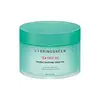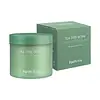What's inside
What's inside
 Key Ingredients
Key Ingredients

 Benefits
Benefits

 Concerns
Concerns

 Ingredients Side-by-side
Ingredients Side-by-side

Melaleuca Alternifolia Leaf Extract
PerfumingWater
Skin ConditioningCentella Asiatica Extract
CleansingButylene Glycol
HumectantMelaleuca Alternifolia Leaf Water
Antimicrobial1,2-Hexanediol
Skin ConditioningMelaleuca Alternifolia Flower/Leaf/Stem Extract
Skin ConditioningBetaine
HumectantDipropylene Glycol
HumectantHydroxyacetophenone
AntioxidantAllantoin
Skin ConditioningPanthenol
Skin ConditioningMelaleuca Alternifolia Leaf Oil
AntioxidantCarbomer
Emulsion StabilisingPolyglyceryl-10 Laurate
Skin ConditioningXanthan Gum
EmulsifyingArginine
MaskingDisodium EDTA
Ethylhexylglycerin
Skin ConditioningCapryloyl Salicylic Acid
Exfoliating4-Terpineol
MaskingMelaleuca Alternifolia Leaf Extract, Water, Centella Asiatica Extract, Butylene Glycol, Melaleuca Alternifolia Leaf Water, 1,2-Hexanediol, Melaleuca Alternifolia Flower/Leaf/Stem Extract, Betaine, Dipropylene Glycol, Hydroxyacetophenone, Allantoin, Panthenol, Melaleuca Alternifolia Leaf Oil, Carbomer, Polyglyceryl-10 Laurate, Xanthan Gum, Arginine, Disodium EDTA, Ethylhexylglycerin, Capryloyl Salicylic Acid, 4-Terpineol
Water
Skin ConditioningButylene Glycol
HumectantGlycerin
HumectantMelaleuca Alternifolia Leaf Extract
Perfuming1,2-Hexanediol
Skin ConditioningAlcohol Denat.
AntimicrobialHydroxyacetophenone
AntioxidantGlycereth-25 PCA Isostearate
EmulsifyingSodium Citrate
BufferingLactobionic Acid
BufferingEthylhexylglycerin
Skin ConditioningPropanediol
SolventGlycereth-26
HumectantDisodium EDTA
Melaleuca Alternifolia Leaf Oil
AntioxidantBiosaccharide Gum-1
HumectantCitric Acid
BufferingHydroxyethylcellulose
Emulsion StabilisingAmmonium Polyacryloyldimethyl Taurate
Emulsion StabilisingHyaluronic Acid
HumectantHydrolyzed Hyaluronic Acid
HumectantSodium Hyaluronate
HumectantBifida Ferment Lysate
Skin ConditioningLactose
HumectantCentella Asiatica Extract
CleansingPhenethyl Alcohol
MaskingMilk Protein
Skin ConditioningPanthenol
Skin ConditioningMadecassoside
AntioxidantWater, Butylene Glycol, Glycerin, Melaleuca Alternifolia Leaf Extract, 1,2-Hexanediol, Alcohol Denat., Hydroxyacetophenone, Glycereth-25 PCA Isostearate, Sodium Citrate, Lactobionic Acid, Ethylhexylglycerin, Propanediol, Glycereth-26, Disodium EDTA, Melaleuca Alternifolia Leaf Oil, Biosaccharide Gum-1, Citric Acid, Hydroxyethylcellulose, Ammonium Polyacryloyldimethyl Taurate, Hyaluronic Acid, Hydrolyzed Hyaluronic Acid, Sodium Hyaluronate, Bifida Ferment Lysate, Lactose, Centella Asiatica Extract, Phenethyl Alcohol, Milk Protein, Panthenol, Madecassoside
 Reviews
Reviews

Ingredients Explained
These ingredients are found in both products.
Ingredients higher up in an ingredient list are typically present in a larger amount.
1,2-Hexanediol is a synthetic liquid and another multi-functional powerhouse.
It is a:
- Humectant, drawing moisture into the skin
- Emollient, helping to soften skin
- Solvent, dispersing and stabilizing formulas
- Preservative booster, enhancing the antimicrobial activity of other preservatives
Butylene Glycol (or BG) is used within cosmetic products for a few different reasons:
Overall, Butylene Glycol is a safe and well-rounded ingredient that works well with other ingredients.
Though this ingredient works well with most skin types, some people with sensitive skin may experience a reaction such as allergic rashes, closed comedones, or itchiness.
Learn more about Butylene GlycolCentella Asiatica Extract (Centella) is derived from an herb native to Southeast Asia. It is famous for its anti-inflammatory and soothing properties.
Centella is rich in antioxidants and amino acids, such as Madecassic Acid and Asiaticoside.
Studies show the compounds in centella help with:
The combination of all these properties makes centella effective at soothing, hydrating, and protecting the skin.
Other great components of centella include Vitamin A, vitamin C, several B vitamins, and Asiatic Acid.
Fun fact: Centella has been used as a medicine and in food for many centuries. As a medicine, it is used to treat burns, scratches, and wounds.
Learn more about Centella Asiatica ExtractDisodium EDTA plays a role in making products more stable by aiding other preservatives.
It is a chelating agent, meaning it neutralizes metal ions that may be found in a product.
Disodium EDTA is a salt of edetic acid and is found to be safe in cosmetic ingredients.
Learn more about Disodium EDTAEthylhexylglycerin (we can't pronounce this either) is commonly used as a preservative and skin softener. It is derived from glyceryl.
You might see Ethylhexylglycerin often paired with other preservatives such as phenoxyethanol. Ethylhexylglycerin has been found to increase the effectiveness of these other preservatives.
Hydroxyacetophenone is antioxidant with skin conditioning and soothing properties. It also boosts the efficiency of preservatives.
This ingredient is not irritating or sensitizing.
Melaleuca Alternifolia Leaf Extract comes from the Tea Tree, Melaleuca alternifolia, Myrtaceae. This tea tree is native to Australia.
Tea Leaf extract contains antimicrobial and anti-acne properties.
This ingredient has perfuming properties and contains linalool and limonene. These fragrance and terpinen components can cause skin sensitivity.
Learn more about the benefits of Tea Tree Oil here.
Learn more about Melaleuca Alternifolia Leaf ExtractThis tea tree oil comes from the leaves of the Tea Tree plant. Tea tree oil has antioxidant, anti-inflammatory, and antimicrobial properties.
According to the book Journal of Profiles of Drug Substances, tea tree helps in reducing acne-causing bacteria such as Propionibacterium acnes. This is due to the Terpinen components of tea tree oil.
Tea tree may cause sensitivity and irritation for some people. This oil naturally contains fragrance such as linalool and limonene.
However, research shows irritation usually occurs when using pure tea tree oil and not in cosmetic products.
Tea tree oil was found to help relieve the symptoms of psoriasis in one study.
Tea tree oil is toxic when ingested. Another study showed it to caused damage to the nervous system of dogs and cats when applied to their skin or given orally.
Learn more about Melaleuca Alternifolia Leaf OilPanthenol is a common ingredient that helps hydrate and soothe the skin. It is found naturally in our skin and hair.
There are two forms of panthenol: D and L.
D-panthenol is also known as dexpanthenol. Most cosmetics use dexpanthenol or a mixture of D and L-panthenol.
Panthenol is famous due to its ability to go deeper into the skin's layers. Using this ingredient has numerous pros (and no cons):
Like hyaluronic acid, panthenol is a humectant. Humectants are able to bind and hold large amounts of water to keep skin hydrated.
This ingredient works well for wound healing. It works by increasing tissue in the wound and helps close open wounds.
Once oxidized, panthenol converts to pantothenic acid. Panthothenic acid is found in all living cells.
This ingredient is also referred to as pro-vitamin B5.
Learn more about PanthenolWater. It's the most common cosmetic ingredient of all. You'll usually see it at the top of ingredient lists, meaning that it makes up the largest part of the product.
So why is it so popular? Water most often acts as a solvent - this means that it helps dissolve other ingredients into the formulation.
You'll also recognize water as that liquid we all need to stay alive. If you see this, drink a glass of water. Stay hydrated!
Learn more about Water